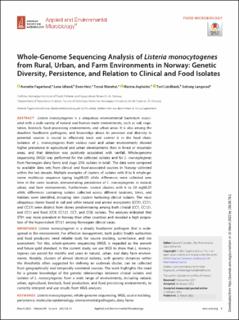| dc.description.abstract | Listeria monocytogenes is a ubiquitous environmental bacterium associated with a wide variety of natural and human-made environments, such as soil, vegetation, livestock, food processing environments, and urban areas. It is also among the deadliest foodborne pathogens, and knowledge about its presence and diversity in potential sources is crucial to effectively track and control it in the food chain. Isolation of L. monocytogenes from various rural and urban environments showed higher prevalence in agricultural and urban developments than in forest or mountain areas, and that detection was positively associated with rainfall. Whole-genome sequencing (WGS) was performed for the collected isolates and for L. monocytogenes from Norwegian dairy farms and slugs (218 isolates in total). The data were compared to available data sets from clinical and food-associated sources in Norway collected within the last decade. Multiple examples of clusters of isolates with 0 to 8 whole-genome multilocus sequence typing (wgMLST) allelic differences were collected over time in the same location, demonstrating persistence of L. monocytogenes in natural, urban, and farm environments. Furthermore, several clusters with 6 to 20 wgMLST allelic differences containing isolates collected across different locations, times, and habitats were identified, including nine clusters harboring clinical isolates. The most ubiquitous clones found in soil and other natural and animal ecosystems (CC91, CC11, and CC37) were distinct from clones predominating among both clinical (CC7, CC121, and CC1) and food (CC9, CC121, CC7, and CC8) isolates. The analyses indicated that ST91 was more prevalent in Norway than other countries and revealed a high proportion of the hypovirulent ST121 among Norwegian clinical cases. | |
